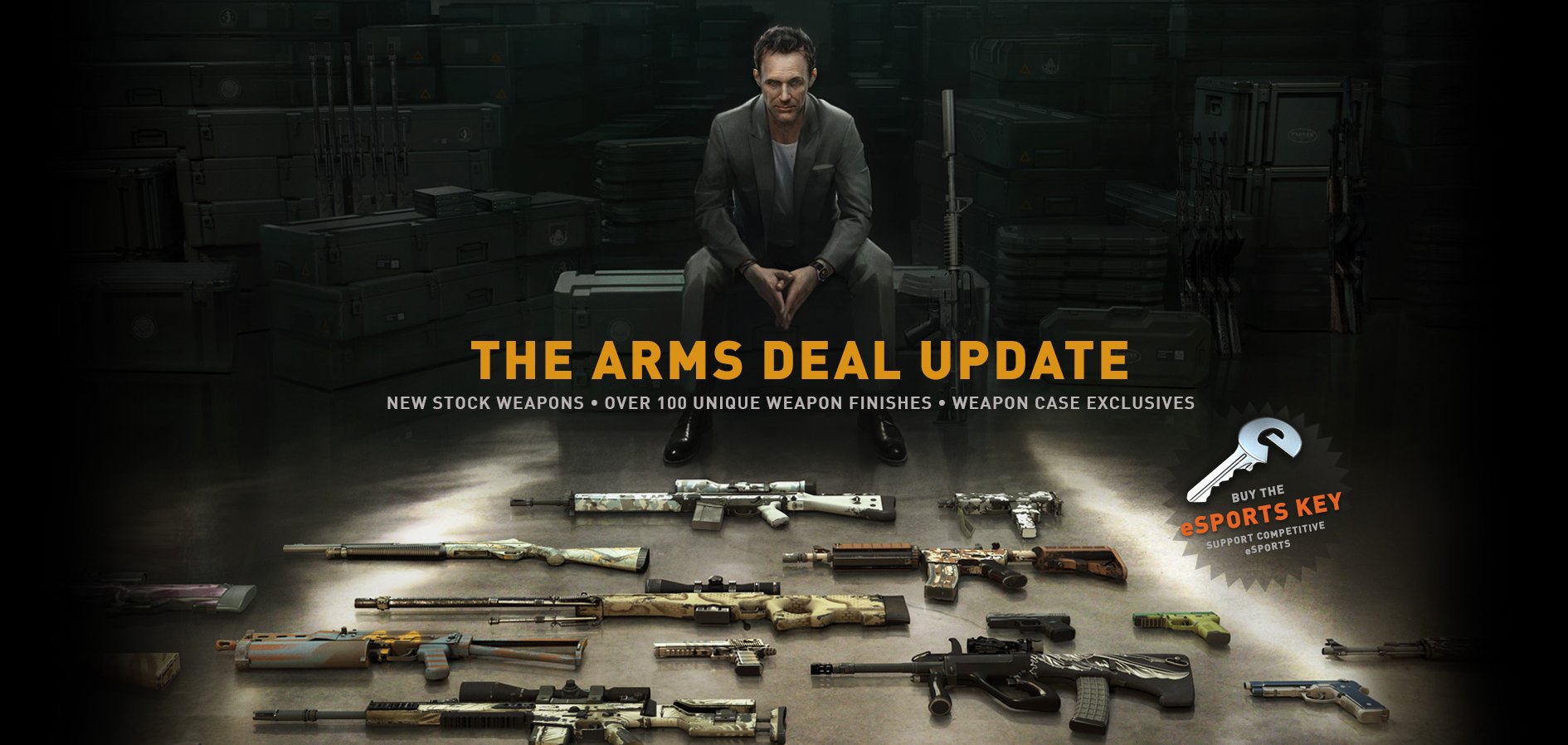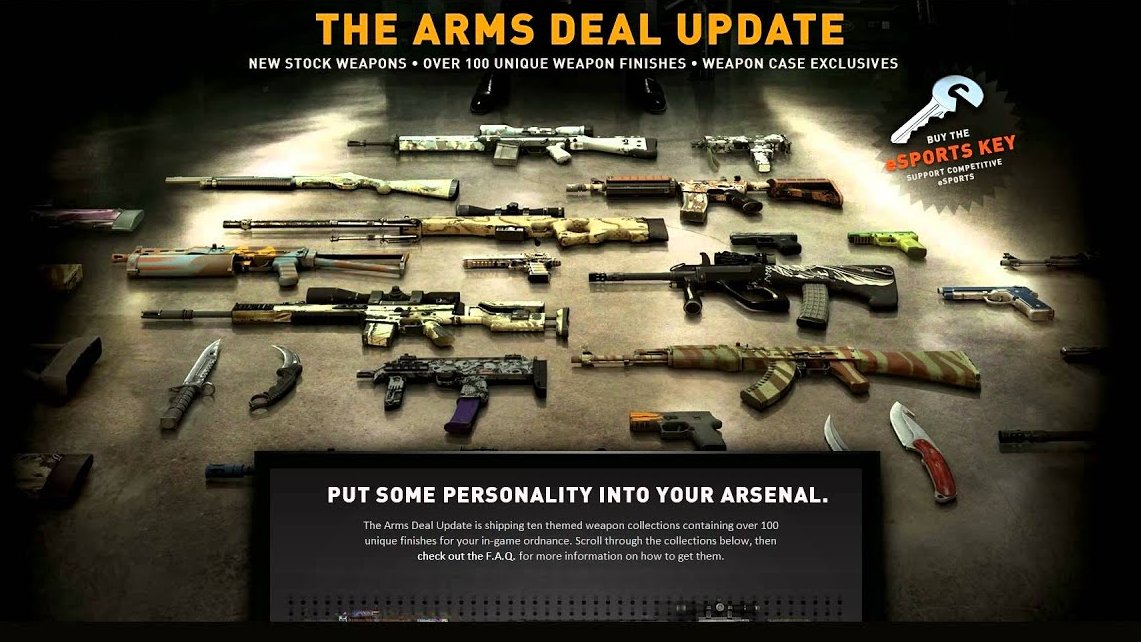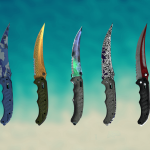
Counter-Strike: Global Offensive (CS:GO) is developed by Valve Corporation, and its skins were initially created by the game’s development team. The game also utilizes a community-driven system where players and fans can submit their own skin designs through the Steam Workshop for consideration to be added to the game.
The exact individual who created the first skin isn’t publicly documented, but it would have been a member of the Valve development team. Unfortunately, without specific details, it’s impossible to name the exact person who made the first skin. However, many talented artists and developers have contributed to the game’s diverse collection of weapon skins.
Arms Deal update in the game – what’s new?
The Arms Deal Update for Counter-Strike: Global Offensive (CS:GO) was released by Valve Corporation in August 2013. This was a significant update that brought a number of new features to the game, including the addition of weapon skins.
Here’s an overview of what was introduced in the Arms Deal Update:
- Weapon Skins: This is perhaps the most significant part of the Arms Deal Update. It added over 100 decorative skins for weapons which could be obtained through various means, such as opening weapon cases or receiving them through random drops at the end of matches.
- Weapon Cases: These cases contain a variety of different weapon skins and can be obtained through random drops. A key, purchased with real money, is needed to open these cases.
- eSports Cases: Similar to the regular weapon cases, but a portion of the proceeds from key sales goes towards prize pools for CS:GO eSports events.
- StatTrak™: Certain weapon skins could come in a StatTrak™ version, which has a built-in counter that records the total number of kills obtained with that weapon.
- Decals: The update also introduced new bomb site decals.
- Two New Stock Weapons: The M4A1-S for CTs and USP-S for Ts were added as alternatives to the M4A4 and P2000, respectively. These new weapons have different statistics and a suppressor that can be attached and detached.
Remember, the Arms Deal update was mainly focused on the cosmetic aspect of the game, adding a new layer of personal customization and monetization through skins and cases, without affecting gameplay balance.

What the 2013 eSports case was like
The 2013 eSports Case in Counter-Strike: Global Offensive (CS:GO) was introduced as part of the Arms Deal Update. This case featured a distinctive red design and a collection of community-designed weapon skins.
The unique aspect of eSports Cases was that a portion of the proceeds from the sales of the eSports Case Keys, used to open these cases, was directed towards funding prize pools for various CS:GO eSports events.
The 2013 eSports Case included the following weapon skins:
- AUG | Wings
- AWP | BOOM
- Desert Eagle | Crimson Web
- FAMAS | Doomkitty
- Glock-18 | Dragon Tattoo
- M4A4 | Faded Zebra
- M4A4 | X-Ray
- P90 | Death by Kitty
- P250 | Splash
- Scar-20 | Splash Jam
- AK-47 | Red Laminate
- SG 553 | Ultraviolet
- USP-S | Serum
It’s important to note that some of these skins had varying rarity grades, ranging from Mil-Spec (blue) to Covert (red). The contents of the case would be received randomly when a player opened it with a key. The skin could also potentially be a StatTrak™ version, which tracks the number of kills the player achieves with that particular weapon.
Weapon Skins
In Counter-Strike: Global Offensive (CS:GO), weapon skins are cosmetic items that change the appearance of the player’s guns or knives without affecting gameplay. They were first introduced to the game in the Arms Deal update in August 2013.
Here are some key aspects of weapon skins in CS:GO:
- Acquisition: Skins can be acquired in various ways, such as through in-game drops at the end of matches, by opening weapon or eSports cases with keys, or by trading with other players.
- Rarity and Quality: Skins come in different levels of rarity, indicated by their color: Consumer Grade (white), Industrial Grade (light blue), Mil-Spec Grade (blue), Restricted (purple), Classified (pink), Covert (red), and Contraband (orange). They also have varying levels of wear or quality, ranging from Factory New to Battle-Scarred.
- StatTrak™: Some skins come in a special StatTrak™ version, which has a built-in counter that records the total number of kills obtained with that weapon.
- Special Skins: There are also special categories of skins like knife skins, gloves, and rare special items.
- Community-Designed Skins: Valve allows community members to design and submit their own skins via the Steam Workshop. Some of these designs are included in the game in new cases or collections.
- Trading and Selling: Skins can be traded or sold on the Steam Market, and some rare or sought-after skins can be quite valuable.
Remember, skins are purely cosmetic and do not change the weapon’s functionality or give any gameplay advantages. They are primarily used for player customization and in-game economy.
Weapon Cases
Weapon Cases are a type of item in Counter-Strike: Global Offensive (CS:GO) that were introduced in the Arms Deal update in August 2013. Each case contains a variety of possible weapon skins that a player can obtain.
Here are some key points about Weapon Cases:
- Acquisition: Cases can be randomly dropped at the end of a match or bought from the Steam Marketplace. They do not require a purchase to receive, but they do require a key to open.
- Opening Cases: To open a Weapon Case, you need a matching key, which can be purchased for real money in the in-game store or the Steam Marketplace. When a case is opened, it will yield one random item from its drop list.
- Drop List: Each case has a specific drop list which contains a number of different weapon skins of varying rarity. The skins are color-coded to indicate their rarity, with red being the rarest and light blue being the most common.
- StatTrak™: Cases can also contain a special version of the weapon skin called StatTrak™. StatTrak™ weapons track the number of kills you get with that specific weapon and display the count on the weapon model itself.
- Trading and Selling: Both cases and the skins obtained from them can be traded or sold on the Steam Marketplace.
It’s important to note that the opening of cases is random, and the chance of getting a highly rare item is quite low. This aspect of CS:GO has drawn comparisons to gambling due to the chance-based nature and real-world value of the items.
eSports Cases
In Counter-Strike: Global Offensive (CS:GO), eSports Cases are a special type of weapon case that were introduced to help support the competitive CS:GO community. These cases function similarly to regular weapon cases, but with a unique aspect: a portion of the proceeds from the sales of eSports Case Keys, used to open these cases, is used to fund prize pools for various CS:GO eSports events.
Like regular weapon cases, eSports cases contain a variety of possible weapon skins that a player can obtain. The exact skins differ from case to case, but all skins available in an eSports case are designed by members of the community.
eSports cases were introduced in the Arms Deal update, which added skins to CS:GO for the first time. Since then, several different eSports cases have been released, each with a unique set of skins.
However, it’s important to note that the drop system in CS:GO is based on chance. Therefore, while some skins are more common than others, getting a particularly rare or valuable skin from an eSports case is not guaranteed.
StatTrak™
StatTrak™ is a feature in Counter-Strike: Global Offensive (CS:GO) introduced with the Arms Deal Update. A weapon with the StatTrak™ feature tracks and displays the number of kills that a player has made with that specific weapon.
StatTrak™ weapons are more valuable than their regular counterparts, due to their added functionality and relative rarity. When a player obtains a StatTrak™ weapon, the kill counter starts at zero and increases with each kill made by the player using that weapon. It’s important to note that the kill count is tied to the weapon itself, so if a StatTrak™ weapon is traded or sold, the kill counter resets to zero for the new owner.
StatTrak™ weapons can be obtained in a few ways:
- Weapon Cases: When a player opens a weapon case with a key, there’s a chance that the weapon skin they receive will be a StatTrak™ version.
- Trade Up Contract: Players can also potentially obtain StatTrak™ weapons through the Trade Up Contract, a tool that allows players to trade ten weapons of the same quality for one weapon of a higher quality.
- Steam Marketplace or Trading: StatTrak™ weapons can be purchased from other players through the Steam Marketplace or traded for other items.
StatTrak™ modules cannot be added to a weapon that doesn’t already have it, nor can it be removed from a weapon that does. It’s also worth noting that StatTrak™ only counts kills made in online matches; kills made in offline matches against bots or in other game modes do not count.
Decals
In Counter-Strike: Global Offensive (CS:GO), decals typically refer to the various visual markings seen throughout the game’s maps. These can include graffiti, posters, signs, or other forms of environmental artwork that add to the game’s atmosphere and realism.
For instance, when a bomb explodes, it leaves behind a charred decal on the ground and walls, adding to the sense of impact and destruction. Additionally, bullet impacts and knife slashes also create decals on the surfaces they hit.
In some updates, Valve has introduced more interactive forms of decals, such as the player-drawn sprays, which allow players to leave their own temporary graffiti in the game environment. These sprays can be obtained through gameplay, purchased, or received from opening cases.
Additionally, player achievements in major tournaments are sometimes commemorated with graffiti decals added to the game map where the event took place. These serve as a kind of historical record of the game’s eSports scene.
As of my knowledge cutoff in September 2021, decals in CS:GO do not directly impact gameplay and are mostly used for visual and atmospheric purposes.
Two New Stock Weapons
In the Arms Deal update for Counter-Strike: Global Offensive (CS:GO), two new stock weapons were introduced: the M4A1-S and the USP-S.
- M4A1-S: This is an alternative to the M4A4 for the Counter-Terrorist side. It’s silenced by default, making it quieter and more accurate but with a smaller magazine size and less total ammunition. Players can choose to use either the M4A4 or the M4A1-S in their loadout, but not both at the same time.
- USP-S: The USP-S is an alternative to the P2000 for the Counter-Terrorist side. Like the M4A1-S, it is also silenced, resulting in reduced noise when firing and improved accuracy but a smaller magazine size. As with the M4A4 and M4A1-S, players must choose between the USP-S and the P2000 in their loadout.
These weapons offer players more tactical choices and playstyle flexibility. The suppressors on these weapons can be manually attached or detached during gameplay, offering players the ability to adapt to different situations. However, it’s important to remember that the silenced versions have less ammunition, which could make a difference in longer rounds or engagements.


